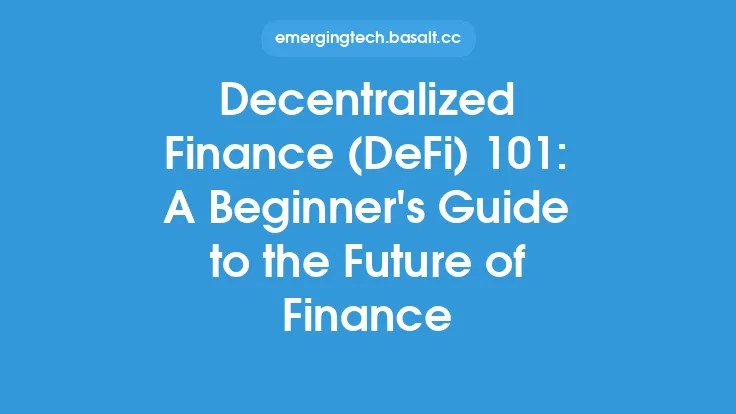The rise of decentralized applications, also known as dApps, has been gaining momentum in recent years. These applications, which operate on blockchain technology, have the potential to disrupt traditional industries in various ways. Decentralized applications are designed to be open-source, autonomous, and decentralized, allowing for peer-to-peer transactions without the need for intermediaries. This characteristic makes them an attractive alternative to traditional centralized systems, which are often plagued by issues such as censorship, corruption, and inefficiency.
What are Decentralized Applications?
Decentralized applications are software programs that run on a blockchain network, allowing for the creation of a decentralized and trustless environment. They are built using smart contracts, which are self-executing contracts with the terms of the agreement written directly into lines of code. This allows for the automation of various processes, reducing the need for intermediaries and increasing the efficiency of transactions. Decentralized applications can be used for a wide range of purposes, including finance, gaming, social media, and more.
Key Characteristics of Decentralized Applications
Decentralized applications have several key characteristics that set them apart from traditional centralized systems. These include:
- Decentralization: Decentralized applications operate on a blockchain network, which is a decentralized and distributed ledger technology.
- Autonomy: Decentralized applications are autonomous, meaning that they can operate without the need for intermediaries or centralized authorities.
- Open-source: Decentralized applications are often open-source, allowing developers to review and modify the code.
- Transparency: Decentralized applications are transparent, with all transactions and data being recorded on a public ledger.
- Security: Decentralized applications are secure, with the use of advanced cryptography and a decentralized network making it difficult for hackers to manipulate the system.
Industries that Can be Disrupted by Decentralized Applications
Decentralized applications have the potential to disrupt a wide range of traditional industries, including:
- Finance: Decentralized applications can be used to create decentralized financial systems, allowing for peer-to-peer transactions and lending without the need for intermediaries.
- Healthcare: Decentralized applications can be used to create secure and decentralized systems for storing and managing medical records.
- Supply Chain Management: Decentralized applications can be used to create transparent and decentralized systems for tracking and verifying the origin and movement of goods.
- Voting Systems: Decentralized applications can be used to create secure and decentralized voting systems, allowing for transparent and tamper-proof elections.
- Social Media: Decentralized applications can be used to create decentralized social media platforms, allowing for users to have more control over their data and online interactions.
Benefits of Decentralized Applications
Decentralized applications have several benefits, including:
- Increased security: Decentralized applications are more secure than traditional centralized systems, with the use of advanced cryptography and a decentralized network making it difficult for hackers to manipulate the system.
- Improved transparency: Decentralized applications are transparent, with all transactions and data being recorded on a public ledger.
- Increased efficiency: Decentralized applications can automate various processes, reducing the need for intermediaries and increasing the efficiency of transactions.
- Reduced costs: Decentralized applications can reduce costs by eliminating the need for intermediaries and reducing the complexity of transactions.
Challenges Facing Decentralized Applications
Despite the potential of decentralized applications, there are several challenges that need to be addressed, including:
- Scalability: Decentralized applications are often limited by the scalability of the underlying blockchain technology.
- Regulation: Decentralized applications are often unregulated, which can make it difficult for them to operate in a legal and compliant manner.
- User adoption: Decentralized applications often require a high degree of technical expertise, which can make it difficult for non-technical users to adopt and use them.
- Interoperability: Decentralized applications often operate on different blockchain platforms, which can make it difficult for them to interoperate and communicate with each other.
Conclusion
Decentralized applications have the potential to disrupt traditional industries in various ways, offering increased security, transparency, efficiency, and reduced costs. However, there are several challenges that need to be addressed, including scalability, regulation, user adoption, and interoperability. As the technology continues to evolve and mature, we can expect to see more widespread adoption of decentralized applications, leading to a more decentralized and autonomous digital world.





